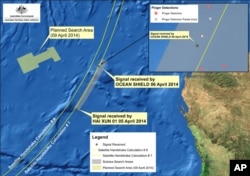The Australian chief of the search team looking for the missing Malaysian jet in the depths of the Indian Ocean is voicing optimism that the plane could soon be found.
Angus Houston said Wednesday that two signals detected a day earlier by a U.S. Navy pinger locator give searchers some reason to hope they will find the wreckage of the jet.
"I'm now optimistic that we will find the aircraft in the not too distant future," he said.
Houston said the most recent signals will help to reduce the search area west of Australia to a "much more manageable" region; but, he added the searchers from several countries "need to visually identify aircraft wreckage before we can confirm with certainty that this is the final resting place of MH370."
He said more signals need to be detected and the search area better refined before authorities can deploy a robot submarine to search the ocean floor.
Authorities are running out of time, as the battery on the plane's black box locator beacon that transmits the "pings" lasts only for about 30 days. The box records key flight data information. If it is found, the box could give investigators vital clues as to what happened to the plane March 8.
The Boeing 777 disappeared on a planned flight from Kuala Lumpur to Beijing, with 239 people aboard.
The Australian Navy ship Ocean Shield, which is carrying the towed pinger locator, first picked up the signals on Saturday and Sunday, before losing them.
Houston said one "ping" was heard Tuesday afternoon for about five minutes. A second was picked up late Tuesday for about seven minutes.
He said the signals, at 33.331 kilohertz and at 1.106 intervals, were consistent with those expected to be transmitted by the black box's beacon.
The retired air chief marshal said search crews were "very fortunate" to have relocated the transmissions, since it has been 33 days since the plane disappeared.
If additional signals are detected, Houston said he hoped to find something "within a matter of days" that would confirm the plane's "final resting place."
Once the black box is retrieved, authorities will be able to determine what happened to the plane. Its fate has become one of the most puzzling mysteries in modern aviation.
The plane vanished without any distress calls, and authorities have refused to rule out any possibilities, including hijacking, sabotage or a mechanical malfunction.
Angus Houston said Wednesday that two signals detected a day earlier by a U.S. Navy pinger locator give searchers some reason to hope they will find the wreckage of the jet.
"I'm now optimistic that we will find the aircraft in the not too distant future," he said.
Houston said the most recent signals will help to reduce the search area west of Australia to a "much more manageable" region; but, he added the searchers from several countries "need to visually identify aircraft wreckage before we can confirm with certainty that this is the final resting place of MH370."
He said more signals need to be detected and the search area better refined before authorities can deploy a robot submarine to search the ocean floor.
Authorities are running out of time, as the battery on the plane's black box locator beacon that transmits the "pings" lasts only for about 30 days. The box records key flight data information. If it is found, the box could give investigators vital clues as to what happened to the plane March 8.
The Boeing 777 disappeared on a planned flight from Kuala Lumpur to Beijing, with 239 people aboard.
The Australian Navy ship Ocean Shield, which is carrying the towed pinger locator, first picked up the signals on Saturday and Sunday, before losing them.
Houston said one "ping" was heard Tuesday afternoon for about five minutes. A second was picked up late Tuesday for about seven minutes.
He said the signals, at 33.331 kilohertz and at 1.106 intervals, were consistent with those expected to be transmitted by the black box's beacon.
The retired air chief marshal said search crews were "very fortunate" to have relocated the transmissions, since it has been 33 days since the plane disappeared.
If additional signals are detected, Houston said he hoped to find something "within a matter of days" that would confirm the plane's "final resting place."
Once the black box is retrieved, authorities will be able to determine what happened to the plane. Its fate has become one of the most puzzling mysteries in modern aviation.
The plane vanished without any distress calls, and authorities have refused to rule out any possibilities, including hijacking, sabotage or a mechanical malfunction.













